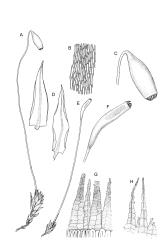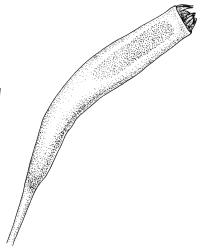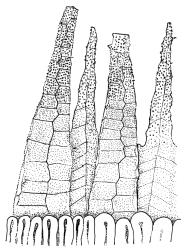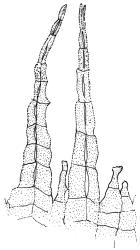- = Pohlia novae-seelandiae Dixon, Bull. Torrey Bot. Club 42: 102 (1915)
Plants green or yellow-green, with an inconspicuous stem, not or weakly lustrous, forming turves. Stems rather short, to c. 10 mm in N.Z. material, mostly unbranched, yellow- to red-brown, in cross-section angled, with incrassate cortical cells and a conspicuous central strand, beset with yellow-brown, very finely papillose rhizoids below. Leaves small, sparse, and distant below, becoming much more crowded and larger towards shoot tip, erect or weakly spreading, little altered when dry, lanceolate to linear-lanceolate, acute, bluntly serrate or serrulate near apex, mostly recurved at mid leaf or below, not decurrent, mostly 1.5–2.5 × 0.25–0.4 mm; upper laminal cells vermicular, firm-walled, 51–75(–100) × 5–7 µm, becoming wider, more oblong, and thinner-walled towards insertion. Costa stout, strongly protruding abaxially, ending in or just below the apex, in cross-section with median guide cells and two stereid bands. Axillary gemmae nil.
Paroicous in N.Z. material, but reported as sometimes dioicous or autoicous. Perichaetia terminal, the ♀ leaves narrowly- or linear-lanceolate, to c. 3 mm. Setae single, yellow-brown, slender and flexuose, variable in length (but mostly 14–23 mm); capsules mostly horizontal due to curvature of the upper setae when moist, horizontal to suberect when dry, narrowly cylindric, symmetric or nearly so, with a neck ± equal to the urn, pale brown, 3.0–4.5 mm; annulus revoluble; operculum conic or weakly beaked. Exostome teeth pale, lanceolate, narrowly bordered, very finely papillose on outer surface, strongly trabeculate on inner surface, extending c. 350 µm beyond the mouth; endostome with non-perforate or weakly perforate segments, and mostly paired but rudimentary cilia. Spores 18–21 µm.
Crum & Anderson 1981, fig. 243 a–h; Smith 2004, fig. 196, 1–6 (as P. elongata var. elongata); Shaw & Ramsay 2013, unnumbered fig.
The stout percurrent costae, paroicous sexuality and distinctly narrowly cylindric and long-necked capsules here facilitate recognition regionally. The narrowly or linear-lanceolate perichaetial leaves and the stout costa often permit the recognition of non-fruiting material. However, P. elongata remains a sparsely documented species in N.Z., with the majority of collections from Otago L.D. Shaw & Ramsay (2013) consider this species throughout its worldwide range to be “widely distributed but never common”.
Pohlia elongata is most likely to be confused with P. nutans, with which it shares a dull appearance and paroicous inflorescences. But the present species differs by having more lanceolate leaves, much narrower, longer, and horizontal to suberect capsules, and endostomal cilia, which are rudimentary or absent. Shaw & Ramsay (2013) considered P. elongata to lack “the diagnostic, although not constant, orange [capsule] colour” of P. nutans, and noted that in Australia some sterile plants of P. elongata may be erroneously referred to P. nutans.
NI: Taranaki (Fanthams Peak Track); SI: Canterbury (Banks Peninsula, Mt Cook area including Sefton Bivouac Ridge and Sebastopol Creek), Otago.
Bipolar. Mainland Australia*. Reported as widely distributed in the northern hemisphere as well as occurring in southern South America, southern Africa, and New Guinea by Shaw & Ramsay (2013).
On sheltered soil banks, often among snow tussocks (Chionochloa spp.) On the North I. occurring at 1065 m on Taranaki–Mt Egmont. On the South I. ranging from 300 m (Tarras) to at least 1650 m (Cardrona Range). Frequently associated species include Bartramia papillata, Ceratodon purpureus, Ditrichum cylindricarpum, and Pohlia cruda.
Material from Glendhu Bluff (K.W. Allison 8336, CHR 429226 & 490425, Otago L.D.) is tentatively referred here, but it has perichaetia borne on short shoots at the base of tufts of plants rather than terminally on elongate unbranched shoots, as is representative of this species. The leaves in this material are also shorter than in the bulk of other N.Z. collections.








